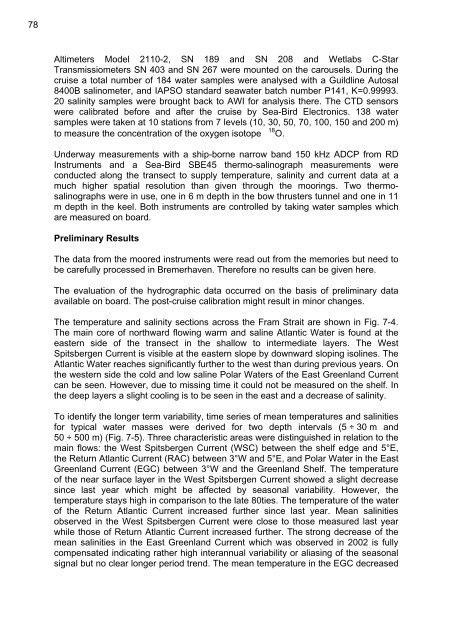the Expedition ARKTIS-XIX/4 of the research vessel POLARSTERN ...
the Expedition ARKTIS-XIX/4 of the research vessel POLARSTERN ...
the Expedition ARKTIS-XIX/4 of the research vessel POLARSTERN ...
You also want an ePaper? Increase the reach of your titles
YUMPU automatically turns print PDFs into web optimized ePapers that Google loves.
78<br />
Altimeters Model 2110-2, SN 189 and SN 208 and Wetlabs C-Star<br />
Transmissiometers SN 403 and SN 267 were mounted on <strong>the</strong> carousels. During <strong>the</strong><br />
cruise a total number <strong>of</strong> 184 water samples were analysed with a Guildline Autosal<br />
8400B salinometer, and IAPSO standard seawater batch number P141, K=0.99993.<br />
20 salinity samples were brought back to AWI for analysis <strong>the</strong>re. The CTD sensors<br />
were calibrated before and after <strong>the</strong> cruise by Sea-Bird Electronics. 138 water<br />
samples were taken at 10 stations from 7 levels (10, 30, 50, 70, 100, 150 and 200 m)<br />
to measure <strong>the</strong> concentration <strong>of</strong> <strong>the</strong> oxygen isotope � 18 O.<br />
Underway measurements with a ship-borne narrow band 150 kHz ADCP from RD<br />
Instruments and a Sea-Bird SBE45 <strong>the</strong>rmo-salinograph measurements were<br />
conducted along <strong>the</strong> transect to supply temperature, salinity and current data at a<br />
much higher spatial resolution than given through <strong>the</strong> moorings. Two <strong>the</strong>rmosalinographs<br />
were in use, one in 6 m depth in <strong>the</strong> bow thrusters tunnel and one in 11<br />
m depth in <strong>the</strong> keel. Both instruments are controlled by taking water samples which<br />
are measured on board.<br />
Preliminary Results<br />
The data from <strong>the</strong> moored instruments were read out from <strong>the</strong> memories but need to<br />
be carefully processed in Bremerhaven. Therefore no results can be given here.<br />
The evaluation <strong>of</strong> <strong>the</strong> hydrographic data occurred on <strong>the</strong> basis <strong>of</strong> preliminary data<br />
available on board. The post-cruise calibration might result in minor changes.<br />
The temperature and salinity sections across <strong>the</strong> Fram Strait are shown in Fig. 7-4.<br />
The main core <strong>of</strong> northward flowing warm and saline Atlantic Water is found at <strong>the</strong><br />
eastern side <strong>of</strong> <strong>the</strong> transect in <strong>the</strong> shallow to intermediate layers. The West<br />
Spitsbergen Current is visible at <strong>the</strong> eastern slope by downward sloping isolines. The<br />
Atlantic Water reaches significantly fur<strong>the</strong>r to <strong>the</strong> west than during previous years. On<br />
<strong>the</strong> western side <strong>the</strong> cold and low saline Polar Waters <strong>of</strong> <strong>the</strong> East Greenland Current<br />
can be seen. However, due to missing time it could not be measured on <strong>the</strong> shelf. In<br />
<strong>the</strong> deep layers a slight cooling is to be seen in <strong>the</strong> east and a decrease <strong>of</strong> salinity.<br />
To identify <strong>the</strong> longer term variability, time series <strong>of</strong> mean temperatures and salinities<br />
for typical water masses were derived for two depth intervals (5 ÷ 30 m and<br />
50 ÷ 500 m) (Fig. 7-5). Three characteristic areas were distinguished in relation to <strong>the</strong><br />
main flows: <strong>the</strong> West Spitsbergen Current (WSC) between <strong>the</strong> shelf edge and 5°E,<br />
<strong>the</strong> Return Atlantic Current (RAC) between 3°W and 5°E, and Polar Water in <strong>the</strong> East<br />
Greenland Current (EGC) between 3°W and <strong>the</strong> Greenland Shelf. The temperature<br />
<strong>of</strong> <strong>the</strong> near surface layer in <strong>the</strong> West Spitsbergen Current showed a slight decrease<br />
since last year which might be affected by seasonal variability. However, <strong>the</strong><br />
temperature stays high in comparison to <strong>the</strong> late 80ties. The temperature <strong>of</strong> <strong>the</strong> water<br />
<strong>of</strong> <strong>the</strong> Return Atlantic Current increased fur<strong>the</strong>r since last year. Mean salinities<br />
observed in <strong>the</strong> West Spitsbergen Current were close to those measured last year<br />
while those <strong>of</strong> Return Atlantic Current increased fur<strong>the</strong>r. The strong decrease <strong>of</strong> <strong>the</strong><br />
mean salinities in <strong>the</strong> East Greenland Current which was observed in 2002 is fully<br />
compensated indicating ra<strong>the</strong>r high interannual variability or aliasing <strong>of</strong> <strong>the</strong> seasonal<br />
signal but no clear longer period trend. The mean temperature in <strong>the</strong> EGC decreased

















